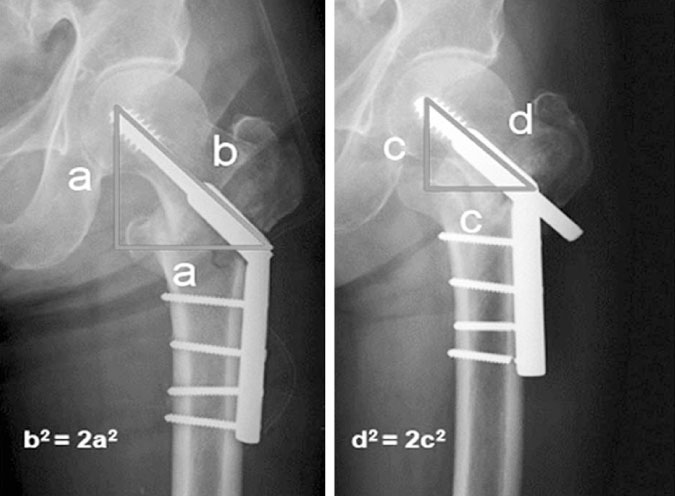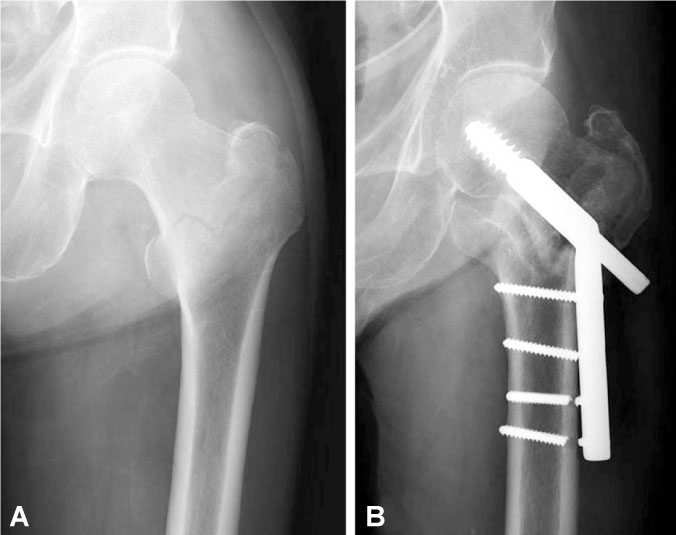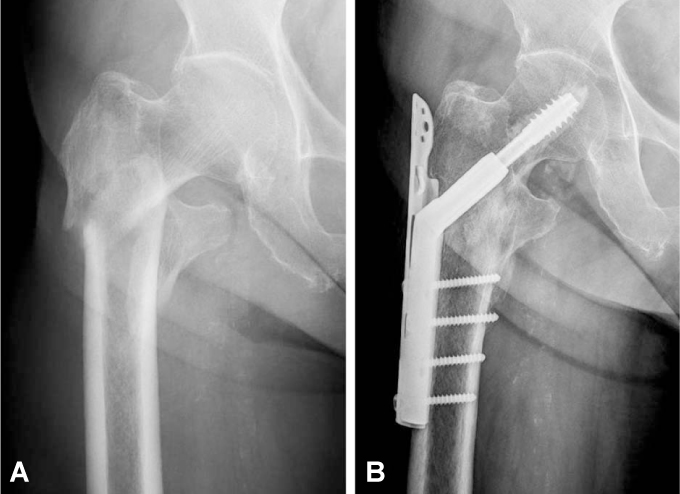J Korean Hip Soc.
2011 Dec;23(4):290-296. 10.5371/jkhs.2011.23.4.290.
The Clinical Results of Pressurized Cement-Augmented Richard Compression Hip Screw with Trochanteric Stabilizing Plate for Intertrochanteric Fracture Compared with Pressurized Cement-Augmented Richard Compression Hip Screw Only
- Affiliations
-
- 1Department of Orthopaedic Surgery, St. Mary's Hospital, College of Medicine, The Catholic University of Korea, Seoul, Korea. sykwon@catholic.ac.kr
- 2Department of Orthopaedic Surgery, Daelim St. Mary's Hospital, Seoul, Korea.
- KMID: 1452637
- DOI: http://doi.org/10.5371/jkhs.2011.23.4.290
Abstract
- PURPOSE
We analyzed the radiologic and clinical outcomes of osteosynthesis using a Richard compression hip screw (RCHS) alone or RCHS with a trochanteric stabilizing plate (TSP) in patients with an intertrochanteric fracture.
MATERIALS AND METHODS
From January 2006 to December 2008, 23 patients (23 cases) underwent osteosynthesis using only RCHS and 24 patients (25 cases) underwent osteosynthesis using RCHS and TSP. We evaluated the classification of fractures, the amount of collapse and shortening, and the duration of fracture union. We used a Koval classification for the evaluation of clinical outcomes.
RESULTS
The amount of collapse and shortening in the RCHS-only group was statistically greater than the amount in the RCHS-with-TSP group. The union duration of fracture was 5.3 months in the RCHS-only group and 6.6 months in the RCHS-with-TSP group. The clinical outcomes in the RCHS-with TSP-group were better than the RCHS-only group. We had one case of fixation failure in the RCHS-only group and none in the RCHS-with-TSP group. There were no perioperative systemic complications or death.
CONCLUSION
In patients with unstable intertrochanteric fractures, we can prevent the cut out of the lag screw or screw loosening with the use of pressurized PMMA-augmented RCHS. However, we cannot prevent excessive collapse and shortening, especially in patients with severe osteoporosis, a small diameter of the femur neck, or concealed fractures. In the case of these patients, we recommend you to use RCHS with TSP for the prevention of excessive collapse and shortening.
Figure
Reference
-
1. Laros GS. Evarts CM, editor. Intertrochnteric fractures. 1990. New York: Churchill Livingstone;2613–2639.2. Bartucci EJ, Gonzalez MH, Cooperman DR, Freedberg HI, Barmada R, Laros GS. The effect of adjunctive methylmethacrylate on failures of fixation and function in patients with intertrochanteric fractures and osteoporosis. J Bone Joint Surg Am. 1985. 67:1094–1107.
Article3. Bonnaire F, Götschin U, Kuner EH. Early and late results of 200 DHS osteosynthesis in the reconstruction of pertrochanteric femoral fractures. Unfallchirurg. 1992. 95:246–253.4. Bridle SH, Patel AD, Bircher M, Calvert PT. Fixation of intertrochantertic fractures of the femur. A randomised prospective comparison of the gamma nail and the dynamic hip screw. J Bone Joint Surg Br. 1991. 73:330–334.5. Haentjens P, Casteleyn PP, DeBoeck H, Handelberg F, Opdecam P. Treatment of unstable intertrochanteric and subtrochanteric fractures in elderly patients. Primary bipolar arthroplasty compared with internal fixation. J Bone Joint Surg Am. 1989. 71:1214–1225.
Article6. Jensen JS. Classification of trochanteric fractures. Acta Orthop Scand. 1980. 51:803–810.
Article7. Müller Färber J, Wittner B, Reichel R. Late results in the management of pertrochanteric femoral fractures in the elderly with the dynamic hip screw. Unfallchirurg. 1988. 91:341–350.8. Clark DW, Ribbans WJ. Treatment of unstable intertrochanteric fractures of the femur: a prospective trial comparing anatomical reduction and valgus osteotomy. Injury. 1990. 21:84–88.
Article9. Dávid A, Hüfner T, Lewandrowski KU, Pape D, Muhr G. The dynamic hip screw with support plate--a reliable osteosynthesis for highly unstable "reverse" trochnateric fractures? Chirurg. 1996. 67:1166–1173.
Article10. Hersche O, Heim D, Bodoky A, Regazzoni P. 4 fragment fractures of the proximal femur: is the dynamic hip screw a suitable impalnt? Helv Chir Acta. 1989. 56:577–580.11. Sarmiento A, Williams EM. The unstable intertrochanteric fracture: treatment with a valgus osteotomy and I-beam nail-plate. A preliminary report of one hundred cases. J Bone Joint Surg Am. 1970. 52:1309–1318.12. Kim BJ, Lee SJ, Kwon SY, Tak KR, Lee KY. A biomechanical study on a new surgical procedure for the treatment of intertrochnteric fractures in relation to osteoporosis of varying degree. J Biomed Eng Res. 2003. 24:401–410.13. Massoud EI. Fixation of basicervical and related fracture. Int Orthop. 2010. 34:577–582.14. Koval KJ, Skovron ML, Aharonoff GB, Meadows SE, Zuckerman JD. Ambulatory ability after hip fracture. A prospective study in geriatric patients. Clin Orthop Relat Res. 1995. 310:150–159.15. Doppelt SH. The sliding compression screw--today's best answer for stabilization of intertrochanteric hip fractures. Orthop Clin North Am. 1980. 11:507–523.
Article16. Koval KJ, Aharonoff GB, Rokito AS, Lyon T, Zuckerman JD. Patients with femoral neck and intertrochanteric fractures. Are they the same? Clin Orthop Relat Res. 1996. 330:166–172.17. Baumgaertner MR, Curtin SL, Lindskog DM, Keggi JM. The value of the tip-apex distance in predicting failure of fixation of peritrochanteric fractures of the hip. J Bone Joint Surg Am. 1995. 77:1058–1064.
Article18. Haidukewych GJ, Israel TA, Berry DJ. Reverse obliquity fractures of the intertrochanteric region of the femur. J Bone Joint Surg Am. 2001. 83-A:643–650.
Article19. Calvert PT. The Gamma nail--a significant advance or passing fashion? J Bone Joint Surg Br. 1992. 74:329–331.20. Friedl W, Colombo-Benkmann M, Dockter S, Machens HG, Mieck U. Gamma nail osteosynthesis of per- and subtrochanteric femoral fractures. 4 years experiences and their consequences for further implant development. Chirurg. 1994. 65:953–963.21. Leung KS, So WS, Shen WY, Hui PW. Gamma nails and dynamic hip screws for peritrochanteric fractures. A randomised prospective study in elderly patients. J Bone Joint Surg Br. 1992. 74:345–351.
Article
- Full Text Links
- Actions
-
Cited
- CITED
-
- Close
- Share
- Similar articles
-
- Treatment of Failed Intertrochanteric Fractures to Maintain the Reduction in Elderly Patients
- Results of Use of Compression Hip Screw with Trochanter Stabilizing Plate for Reverse Oblique Intertrochanteric Fracture
- Treatment of an Unstable Intertrochanteric Fracture of The Femur Using a PMMA Augmented Compression Hip Screw
- Treatment of Unstable Interochanteric Femoral Fracture using Compression Hip Screw with additional Transfixations Screw
- Comparison Between Ender Nail and Compression Hip Screw in the Treatment of Intertrochanteric Fracture of Femur




